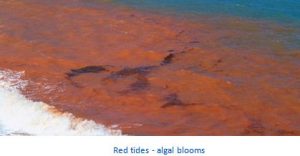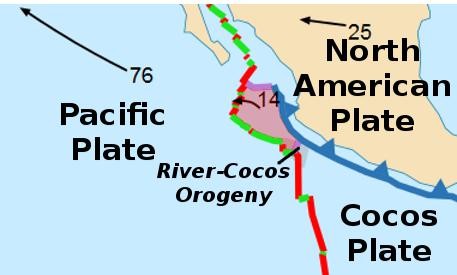By Terry Sovil from the April 2017 Edition
Saltwater is alive with microscopic life. See the photo of a single drop of sea water magnified 25 times. That will keep you on the beach! Most is harmless and forms the base of the food chain, food that ultimately all aquatic life depends on. Algae grows in balance with the ecosystem it is in, limited by the nutrients in the water. Sometimes certain species of algae can reproduce extremely fast and damage the area. Algae that “blooms” into dense patches near the surface are often called RED TIDES.
That will keep you on the beach! Most is harmless and forms the base of the food chain, food that ultimately all aquatic life depends on. Algae grows in balance with the ecosystem it is in, limited by the nutrients in the water. Sometimes certain species of algae can reproduce extremely fast and damage the area. Algae that “blooms” into dense patches near the surface are often called RED TIDES.
Red Tide is a term that has been used for a long time but the newer term for an algal bloom associated with potentially harmful toxins is a “Harmful Algal Bloom” or HAB. One reason is that a HAB is not associated with tidal water movement and may not be red or any color at all.
 A HAB can harm by producing toxins which can kill marine organisms, make shellfish inedible, foul the air with a nasty smell and sometimes cause skin irritations. HABs occur all over the world. Marine scientists from Texas A & M University report that in the past 15 years there have been more blooms re- ported than in the previous 50 years!
A HAB can harm by producing toxins which can kill marine organisms, make shellfish inedible, foul the air with a nasty smell and sometimes cause skin irritations. HABs occur all over the world. Marine scientists from Texas A & M University report that in the past 15 years there have been more blooms re- ported than in the previous 50 years!
HAB creation could be influenced by rich runoff from land or a warming climate. HABs can do serious damage such as the devastation of Long Island, New York’s scallop fishery and closure of shellfish beds. As the toxin moves up the food chain it can impact fish, overgrow on corals, close harbors or block sunlight to seagrass and other critters. Larger forms of algae, such as seaweed, may grow out of control in areas with high runoff from land or sewage pollution.
Scientists are working to develop sensors that would detect three types of dangerous algae providing an  early warning to a HAB. Forecasting systems can pull satellite images and information from weather buoys and form some estimates on how a HAB might spread.
early warning to a HAB. Forecasting systems can pull satellite images and information from weather buoys and form some estimates on how a HAB might spread.
People in Mexico are not strangers to HABs. See the map labeled “Areas in Mexico with Toxic HABs”. The map shows areas that have experienced toxic HABs all around Mexico (Pacific, Sea of Cortez, Gulf of Mexico and Caribbean).
The map was prepared from data collected in over 100 reports from various researchers. Their reports were in various forms of media so it was studied and put into standard categories. One conclusion is that there are just a few cases where the toxins and the impact they had on the ecology and social and eco- nomic impacts were studied. Very little data is provided about the conditions that triggered the sudden HAB blooms along the Mexican coast. They found several times when studies from various researchers point to the same location. This doesn’t mean that the same HAB bloom was reported repeatedly but that location was hit several times.
The events reported seem to say the Pacific Coast had more HAB events than the rest of Mexico (East side) combined. It could also simply indicate more research has been done on the Pacific side.
A recent study indicates the temperature and salinity of the water can help HABs grow. They found a temperature of 10-30C, 50-86 F, and salinity of 10-40 maximized growth rate up to .41 per day at a combination of 25C, 77 F, and salinity of 34. The optimum growth rate of >0.3 per day were with temperatures of 21 to 26C, 70 to 79F, and salinities from 30-36. They did not grow at temperatures less than 10C, 50F, and only grew at sa- linities >30 if the temperature was >15C, 59F. The normal salinity for sea water is around 35 parts per 1,000 or 35 ppk (parts per thousand).
So what does that mean to Manzanillo? Here’s a table that puts us in the “good grower” area:
 There is little danger to humans but swimming in a HAB can leave you, and your swimsuit or wetsuit, very smelly and dirty. It’s much harder to clean up than normal. Visibility can be poor. If you have an open wound, abrasions with susceptible skin, eye and / or upper respiratory tract and ear problems you may want to avoid the water when a HAB is present. People who consume contaminated shellfish (mussels, clams, oysters and scallops) may contract one of four shellfish poisonings. They are: Paralytic Shellfish Poisoning (PSP), Amnesic Shellfish Poisoning (ASP) (rare), Diarrheal Shellfish Poisoning (DSP) and Neurotoxic Shellfish Poisoning (NSP).
There is little danger to humans but swimming in a HAB can leave you, and your swimsuit or wetsuit, very smelly and dirty. It’s much harder to clean up than normal. Visibility can be poor. If you have an open wound, abrasions with susceptible skin, eye and / or upper respiratory tract and ear problems you may want to avoid the water when a HAB is present. People who consume contaminated shellfish (mussels, clams, oysters and scallops) may contract one of four shellfish poisonings. They are: Paralytic Shellfish Poisoning (PSP), Amnesic Shellfish Poisoning (ASP) (rare), Diarrheal Shellfish Poisoning (DSP) and Neurotoxic Shellfish Poisoning (NSP).

So the biggest danger to people during a HAB is from eating shellfish that have absorbed the toxins from the water. If during a HAB where you have eaten shellfish you experience tingling in the lips, a numbness, abdominal pains and diarrhea you should seek medical help quickly. In Mexico, all cases of hospi- talization and casualties due to Red Tides have been PSP- related. If you want more details on poisoning visit DAN (Divers Alert Network) here: https://www.diversalertnetwork.org/health/ hazardous-marine-life/red-tide-and-shellfish-poisonings.
Know what you are eating!
Download the full edition or view it online
—
Terry is a founding partner and scuba instructor for Aquatic Sports and Adventures (Deportes y Aventuras Acuáticas) in Manzanillo. A PADI (Professional Association of Dive Instructors) Master Instructor in his 36th year as a PADI Professional. He also holds 15 Specialty Instructor Course ratings. Terry held a US Coast Guard 50-Ton Masters (Captain’s) License. In his past corporate life, he worked in computers from 1973 to 2005 from a computer operator to a project manager for companies including GE Capital Fleet Services and Target. From 2005 to 2008, he developed and oversaw delivery of training to Target’s Loss Prevention (Asset Protection) employees on the West Coast, USA. He led a network of 80+ instructors, evaluated training, performed needs assessments and gathered feedback on the delivery of training, conducted training in Crisis Leadership and Non-Violent Crisis Intervention to Target executives. Independently, he has taught hundreds of hours of skills-based training in American Red Cross CPR, First Aid, SCUBA and sailing and managed a staff of Project Managers at LogicBay in the production of multi-media training and web sites in a fast-paced environment of artists, instructional designers, writers and developers, creating a variety of interactive training and support products for Fortune 1000 companies.




